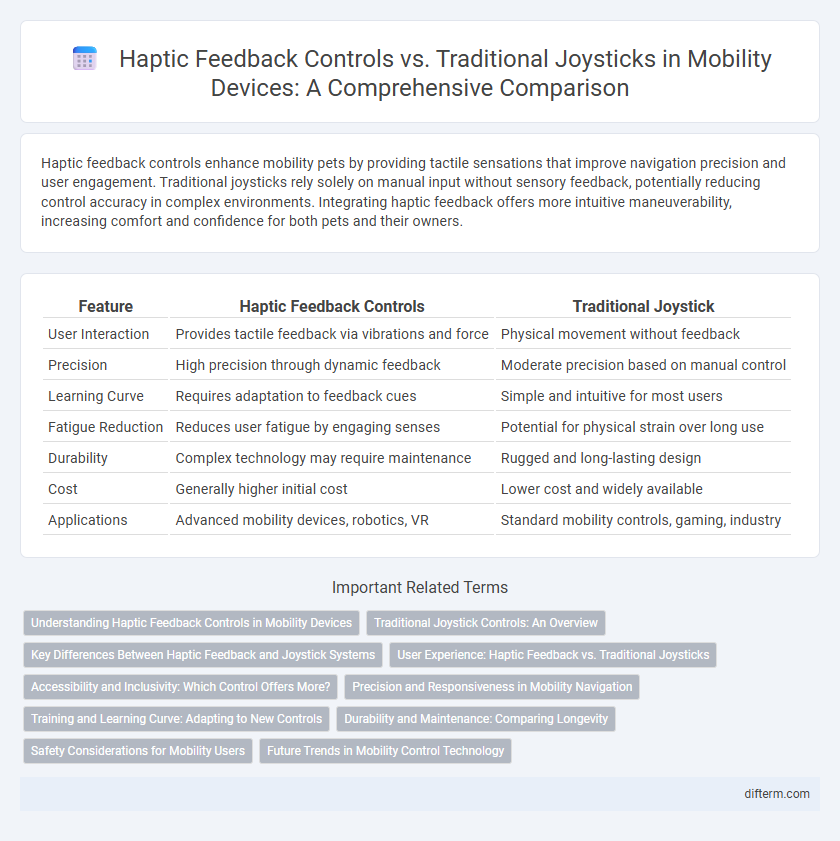Haptic feedback controls enhance mobility pets by providing tactile sensations that improve navigation precision and user engagement. Traditional joysticks rely solely on manual input without sensory feedback, potentially reducing control accuracy in complex environments. Integrating haptic feedback offers more intuitive maneuverability, increasing comfort and confidence for both pets and their owners.
Table of Comparison
| Feature | Haptic Feedback Controls | Traditional Joystick |
|---|---|---|
| User Interaction | Provides tactile feedback via vibrations and force | Physical movement without feedback |
| Precision | High precision through dynamic feedback | Moderate precision based on manual control |
| Learning Curve | Requires adaptation to feedback cues | Simple and intuitive for most users |
| Fatigue Reduction | Reduces user fatigue by engaging senses | Potential for physical strain over long use |
| Durability | Complex technology may require maintenance | Rugged and long-lasting design |
| Cost | Generally higher initial cost | Lower cost and widely available |
| Applications | Advanced mobility devices, robotics, VR | Standard mobility controls, gaming, industry |
Understanding Haptic Feedback Controls in Mobility Devices
Haptic feedback controls in mobility devices provide tactile sensations that enhance user interaction by simulating real-world touch and pressure, improving precision and safety compared to traditional joysticks. These advanced controls enable users to receive immediate sensory cues, which can reduce cognitive load and increase confidence during navigation. Integrating haptic technology in mobility aids promotes more intuitive operation, crucial for individuals with limited sensory or motor functions.
Traditional Joystick Controls: An Overview
Traditional joystick controls in mobility devices provide precise maneuverability through intuitive directional input, utilizing mechanical or electronic sensors to detect motion. These controls are widely adopted due to their reliability, ease of use, and compatibility with various mobility aids such as wheelchairs and electric scooters. Despite advancements in haptic feedback technology, traditional joysticks remain a cost-effective and robust solution for users requiring straightforward navigation and control.
Key Differences Between Haptic Feedback and Joystick Systems
Haptic feedback controls provide tactile sensations that simulate real-world touch, enhancing user interaction and precision in mobility applications, unlike traditional joysticks which rely solely on physical movement without sensory feedback. Joystick systems offer straightforward directional control but lack the immersive experience and adaptive force responses delivered by haptic technology. The key difference lies in haptic feedback's ability to convey dynamic environmental cues, improving maneuverability and user confidence in complex driving or navigation scenarios.
User Experience: Haptic Feedback vs. Traditional Joysticks
Haptic feedback controls enhance user experience by providing tactile sensations that simulate real-world interactions, improving spatial awareness and precision in mobility applications. Traditional joysticks lack this sensory input, often resulting in less intuitive, less immersive control, which can increase user fatigue and reduce response accuracy. Integrating haptic feedback contributes to safer and more engaging navigation by delivering immediate physical cues that traditional joysticks cannot offer.
Accessibility and Inclusivity: Which Control Offers More?
Haptic feedback controls enhance accessibility by providing tactile sensations that guide users with visual or motor impairments, making navigation more intuitive than traditional joysticks. These controls support inclusivity by adapting to diverse user needs through customizable feedback patterns, accommodating different levels of dexterity and sensory preferences. Traditional joysticks often rely on manual precision and lack multisensory feedback, limiting their effectiveness for users with disabilities.
Precision and Responsiveness in Mobility Navigation
Haptic feedback controls significantly enhance precision in mobility navigation by providing real-time tactile responses that allow users to make more accurate adjustments compared to traditional joysticks. This technology increases responsiveness through immediate sensory feedback, reducing the delay between user input and system reaction, which is crucial for maneuvering in complex environments. Studies show haptic systems improve control accuracy by up to 30%, leading to safer and more efficient navigation for mobility device users.
Training and Learning Curve: Adapting to New Controls
Haptic feedback controls accelerate training by providing users with tactile cues that enhance spatial awareness and reduce reliance on visual input compared to traditional joysticks. This sensory input shortens the learning curve, enabling quicker adaptation to complex mobility systems such as robotic prosthetics or remote vehicle navigation. Studies show operators achieve proficiency faster with haptic-enabled devices, improving overall system efficiency and reducing training time.
Durability and Maintenance: Comparing Longevity
Haptic feedback controls offer superior durability compared to traditional joysticks due to fewer mechanical components subject to wear and tear. Their solid-state design reduces the need for frequent maintenance, extending the operational lifespan in mobility applications. Traditional joysticks often require regular calibration and part replacements, increasing downtime and long-term costs.
Safety Considerations for Mobility Users
Haptic feedback controls enhance safety for mobility users by providing tactile responses that reduce reliance on visual cues, minimizing distractions and improving spatial awareness. Unlike traditional joysticks, haptic controls offer real-time feedback on obstacles and terrain changes, enabling quicker reaction times and preventing accidents. These advanced sensory inputs contribute to lower fall risks and promote more confident navigation in various environments.
Future Trends in Mobility Control Technology
Haptic feedback controls in mobility systems enhance user interaction by providing tactile sensations that simulate real-world touch, improving precision and reducing driver fatigue compared to traditional joysticks. Emerging trends indicate a shift towards integrating advanced haptic technology with AI and sensor fusion to create adaptive, intuitive control interfaces for autonomous and electric vehicles. This evolution promises greater safety, accessibility, and user experience improvements in next-generation mobility solutions.
haptic feedback controls vs traditional joystick Infographic

 difterm.com
difterm.com